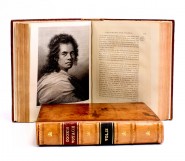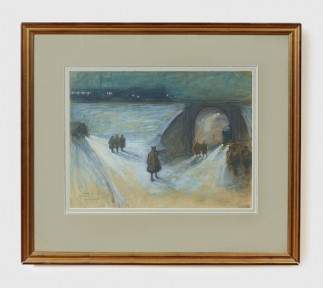Lot #35 - Isobel Rae
-
Auction House:Bonhams Australia
-
Sale Name:Important Australian Art
-
Sale Date:23 Aug 2022 ~ 7pm (AEST)
-
Lot #:35
-
Lot Description:Isobel Rae
(1860-1940)
Night Patrol, 1918
charcoal and pastel on grey paper
47.0 x 62.0cm (18 1/2 x 24 7/16in).
signed, dated and inscribed lower left: 'ISO RAE / ETAPLES / January 1918' -
Provenance:Sir Leon and Lady Trour, Brisbane; Phillip Bacon Galleries, Brisbane; Private collection, Brisbane, acquired from the above in 1989
-
Notes:'It was not until 1918 that sixteen men were appointed as Australia's official war artists for the First World War. No women were chosen. Yet there was an Australian woman artist who lived in France for the whole war, and who since 1915 quietly documented the activities of the Étaples Army Base Camp. Her name was Iso Rae. Rae was born in Melbourne in 1860. At 17 she became a student at the National Gallery School in Melbourne, along with students who were to become household names in Australia: Tom Roberts, John Longstaff, Frederick McCubbin and Rupert Bunny. Ten years later, in 1887, Rae moved to Paris together with her mother Janet and her sister Alison. During the three years in Paris, Rae was influenced by the French Post-Impressionist artists. In her drawings she uses black outlines filled with flat areas of colour, a post-impressionist technique reminiscent of some of the French poster artists of the late nineteenth century. In 1890 the three women moved to Étaples in Picardy, where an artists' colony of Australians, British and Americans had congregated. Working from Étaples, Rae exhibited and sold her large oil paintings in the Paris Salon and in London, and was favourably reviewed by art critics. A quarter of a century later, the outbreak of the First World War found the group still settled in Étaples. The war drove most of the Australians either home or to England, but Rae's mother was ill and it was thought best not to move her... And so the family remained. Iso Rae became one of only two Australian women artists to document the war in France. (The other was Jessie Traill, who was working in a military hospital in Rouen.) Étaples is a very old fishing town and port, which lies at the mouth of the River Canche in the region of Pas de Calais in Picardy. The Étaples Army Base Camp, the largest of its kind ever established overseas by the British, was built along the railway adjacent to the town. It was served by a network of railways, canals, and roads connecting the camp to the southern and eastern fields of battle in France and to ships carrying troops, supplies, guns, equipment, and thousands of men and women across the English Channel. It was a base for British, Canadian, Scottish and Australian forces. The camp was a training base, a depot for supplies, a detention centre for prisoners, and a centre for the treatment of the sick and wounded, with almost twenty general hospitals. At its peak, the camp housed over 100,000 people; altogether, its hospitals could treat 22,000 patients. With its vast conglomeration of the wounded, of prisoners, of soldiers training for battle, and of those simply waiting to return to the front, Étaples could appear a dark place.'1 1. Betty Snowden, 'Iso Rae in Étaples: another perspective of war', Wartime, no. 8, 1999, pp. 36–41
-
Estimate:A$10,000 - 15,000
-
Realised Price:
-
Category:Art
This Sale has been held and this item is no longer available. Details are provided for information purposes only.










